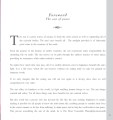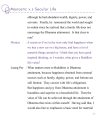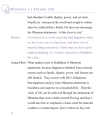external pursuits : ค้นหาหนังสือธรรมะ หน้า 2 / 8
หน้าหนังสือทั้งหมด

27
The Concept of the Unknown Factor in Human Belief
Luang Por: "Humans are categorized into two groups: either believing that the Unknown Factor exists, or believing that it does not exist. There are, of course, atheists, who say that the possibility e
Luang Por categorizes humans into two groups based on belief in the Unknown Factor, discussing atheists inclusively in those who believe. He elaborates on those who perceive this factor as necessary f

54
Understanding Kamma and Its Impact on Life Choices
"And what is Kamma? Kamma is action with intention. Am I always being mindful of what I am doing? Am I using my mind and listening to my mind? Am I listening to my outside voice or my inside voice? Th
Kamma refers to action with intention. It emphasizes the need for mindfulness in our actions and decisions, distinguishing between our external influences (kilesa) and our internal compassionate voice

32
The Essence of Inner Peace and World Harmony
"hat has been a wonderful experience here in this temple is that all religions are welcome. We sit side by side and meditate. The Abbot’s vision of world peace through inner peace is absolutely unique
This text emphasizes the importance of inner peace as a foundation for world peace, advocating for empathy among diverse religions and cultures. Hollywood actor Gary Stretch shares his experience in a

11
The Sun of Peace
Foreword
The sun of peace
The sun is a great source of energy. It leads the solar system as well as supporting all of
the celestial bodies. The sun's rays benefit all. The sunlight provided is of in
The foreword discusses the sun as a vital energy source that sustains life on earth and serves as a metaphor for enlightenment. It draws parallels between the sun's unwavering presence and the dedicat

11
Inner Peace and Happiness at Dhammakaya Temple
Since its establishment in 1970, the temple
has been promoting the concept that true happiness
comes from within, that attaining inner peace as
an individual is prerequisite to world peace arising.
an
Established in 1970, Dhammakaya Temple advocates that true happiness stems from within. It posits that achieving inner peace is essential for global harmony, emphasizing that to resolve external confl

307
Meditation in Everyday Life
Meditation in Everyday Life
remind you. We do these things on a daily basis
not because someone compels us to, but rather
because they are necessities in life. This is in the
same way that meditation
Meditation is essential for mental health, much like daily physical activities are for the body. Engaging in meditation daily enhances your well-being and can become a natural part of life, just as br

231
Understanding Dhammakaya: The Nature of Wisdom
Wisdom
like our mind. The Dhammakaya has been there,
naturally, since we were born. The Dhammakaya
has nothing to do with religion, race, or personal
belief. Just because I cannot see the Dhammakaya
w
The text discusses the concept of Dhammakaya, suggesting that it exists inherently within all individuals, regardless of external influences. It emphasizes the importance of refining one's mind to per

38
The Importance of Internal Happiness and Community Spaces
Šuzanne Jeffrey
ride: When you have something new to wear, you feel good about yourselves, but when
you don’t, you feel badly about yourselves. And the only thing that seems to satisfy
people is alwa
In this insightful segment, Suzanne Jeffrey discusses the connection between external desires and internal happiness, emphasizing the importance of focusing on appropriate clothing rather than just fa

61
Pāli Literature and Studies
Vanarathne, Ranjith.
1980. *Theravadi Samanera Banadaham Pota.* Colombo:
Samayawadhana.
Wardar, A.K.
1967. *Pali Metre: A Contribution to the History of Indian Literature.* London: The Pali Text Soci
This collection highlights significant works in Pāli literature, including Ranjith Vanarathne's *Theravadi Samanera Banadaham Pota*, and A.K. Wardar's *Pali Metre*. Additionally, it features articles

218
Journey to Joy
Journey to Joy
218
I didn't want to come out of this comfort
zone. I wanted to continue sitting and observing.
I didn't feel tired, cold or hot, or uncomfortable,
and I felt I could sit in that positi
This text reflects on the profound experience of meditation leading to a deeper understanding of happiness and inner peace. The author shares how meditation has transformed their perspective, enabling

22
Journey to Joy
Journey to Joy
able to practise even though their faiths
from one another.
may differ
222
22
The true happiness sought by all people
can be found within each of us. It is not an
external power or obje
True happiness is found within us and not in external objects or powers. Achieving happiness requires a completely still mind. When the mind is at peace, happiness naturally follows. This can be pract

33
Dr. Michael Nobel's Endorsement of Meditation
Dr. Michael Nobel's Endorsement
Now, meditation is a truly wonderful tool. It re-
quires no instruments, no drugs, no external assis-
tance once the basics are acquired, and no baggage
to carry around
In his endorsement, Dr. Michael Nobel emphasizes that meditation is a powerful tool that requires no external resources and can enhance peace, happiness, and self-confidence. He encourages people to s

18
Golden Age of Inner Peace
Golden Age of Inner Peace
our spirit, but many do not realise that ongoing
meditation training will also bring true happiness
and peace. This is because, through meditation,
true happiness and peace a
The text emphasizes the importance of ongoing meditation training in achieving true happiness and peace. It argues that these qualities can be attained internally rather than through external sources

143
Truth for the Family: Understanding Precepts and Human Nature
Part Five: Truth for the Family
stockpile of behavioral (social, emotional and spiritual)
problems, creating a generation of people who are only
interested in themselves. Ignorance is the force behind
In this section, we discuss how behavioral problems contribute to a self-centered generation and the role ignorance plays in social issues. Parents often blame external factors for their children's st

25
Monastic vs Secular Life in Buddhism
Monastic v.s Secular Life
Monica
Luang Por
although he had abundant wealth, dignity, power, and
servants. Finally, he renounced the world and sought
to ordain since he realized that a family life does
This text discusses the differences between monastic and secular life through the eyes of a Buddhist perspective. It highlights how a renunciation of material wealth and societal status opens the path

43
Understanding and Overcoming Defilements in Meditation
Suzanne Jeffrey
from defilement are manifested within the mind since we are born. It forces the mind to
think, speak, and act imperfectly and it allows us to slide into bad habits. Finally, defile-
m
This text discusses the concept of defilements, which manifest in the mind from birth and lead to bad habits and suffering. It emphasizes the need for right understanding and mind control, urging prac

35
Study of Buddhist Texts and Sectarian Developments
HONJŌ, Yoshifumi (本庄良文).
1992 “Saurātantika.” Indogaku-Bukkyōgaku-kenkyū 印度学仏教学研究 40(2): 148-154(L).
NATIER, Janice J., Charles S. PREBISH.
1977 “Mahāsāṃghika Origins: The Beginnings of Buddhist Sect
This compilation includes vital research contributions on Buddhist sectarian origins and the study of specific texts. Notable works such as Yoshifumi Honjō's study on Saurātantika and Janice Natier's

180
A True Buddhist
Chapter 41
A True Buddhist
When I reviewed my notes from a sermon given by a
respected senior monk during my research for this book, I
incidentally came upon a valuable message. That is, "What
is the
In a recent chapter, insights from a senior monk reveal that Buddhism's decline is primarily due to the diminishing faith of its followers. The monk categorizes the causes into 'External Fool' and 'In

25
Monastic vs Secular Life: Finding True Happiness
Monastic v.s Secular Life
Monica
happiness and the highest satisfaction in life for us.
Prince Siddharta, as an example, rejected his excess
royal wealth because he foresaw that they provided
limited
This text discusses the journey towards true happiness and satisfaction in life, contrasting monastic life represented by Prince Siddharta, who renounced royal wealth for enlightenment, with secular l

24
Monastic vs Secular Life: Insights on Dhamma
Monastic v.s Secular Life
Monica
had abundant wealth, dignity, power, and servants.
Finally, he renounced the world and sought to ordain
since he realized that a family life does not encourage
the Dha
In this discussion, the speaker reflects on the differences between monastic and secular lifestyles, emphasizing the pursuit of Dhamma as the true source of happiness, in contrast to material possessi
